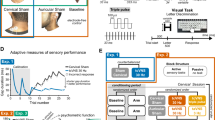Abstract
Sensory tricks are clinical maneuvers that may partially relieve dystonic contractions. Any clinical maneuver that modulates afferent sensory and efferent motor pathways could be used as a sensory trick in patients with cervical dystonia. Although various sensory tricks have been described to reduce cervical dystonia, little is known about the exact mechanisms by which they operate. We report a case of cervical dystonia that was alleviated through the use of a visual-sensory trick. Our findings suggest that visual stimulation might be an effective sensory trick in cervical dystonia by compensating for a defective sensory system, or because visual pathways might be also affected by sensory interactions in cervical dystonia.

Similar content being viewed by others
References
Nutt JG, Muenter MD, Aronson A, Kurland LT, Melton LJ 3rd (1988) Epidemiology of focal and generalized dystonia in Rochester, Minnesota. Mov Disord 3:188–194
Renga (2000) A prevalence study of primary dystonia in eight European countries. J Neurol 247:787–792
Asgeirsson H, Jakobsson F, Hjaltason H, Jonsdottir H, Sveinbjornsdottir S (2006) Prevalence study of primary dystonia in Iceland. Mov Disord 21:293–298
Muller J, Wissel J, Masuhr F, Ebersbach G, Wenning GK et al (2001) Clinical characteristics of the geste antagoniste in cervical dystonia. J Neurol 248:478–482
Consky ESLA (1994) Clinical assessments of patients with cervical dystonia. In: Jankovic J, Hallett M (eds) Therapy with botulinum toxin. Marcel Dekker, New York, pp 211–237
Jankovic J, Tolosa E (2007) Parkinson’s disease and movement disorders. Lippincott Williams & Wilkins. xiv, Philadelphia, p 720
Bove M, Brichetto G, Abbruzzese G, Marchese R, Schieppati M (2004) Neck proprioception and spatial orientation in cervical dystonia. Brain 127:2764–2778
Abbruzzese G, Berardelli A (2003) Sensorimotor integration in movement disorders. Mov Disord 18:231–240
Ceballos-Baumann AO, Passingham RE, Warner T, Playford ED, Marsden CD et al (1995) Overactive prefrontal and underactive motor cortical areas in idiopathic dystonia. Ann Neurol 37:363–372
Ibanez V, Sadato N, Karp B, Deiber MP, Hallett M (1999) Deficient activation of the motor cortical network in patients with writer’s cramp. Neurology 53:96–105
Naumann M, Magyar-Lehmann S, Reiners K, Erbguth F, Leenders KL (2000) Sensory tricks in cervical dystonia: perceptual dysbalance of parietal cortex modulates frontal motor programming. Ann Neurol 47:322–328
Andersen RA, Snyder LH, Bradley DC, Xing J (1997) Multimodal representation of space in the posterior parietal cortex and its use in planning movements. Annu Rev Neurosci 20:303–330
Wise SP, Boussaoud D, Johnson PB, Caminiti R (1997) Premotor and parietal cortex: corticocortical connectivity and combinatorial computations. Annu Rev Neurosci 20:25–42
Azulay JP, Mesure S, Amblard B, Blin O, Sangla I et al (1999) Visual control of locomotion in Parkinson’s disease. Brain 122(Pt 1):111–120
Suteerawattananon M, Morris GS, Etnyre BR, Jankovic J, Protas EJ (2004) Effects of visual and auditory cues on gait in individuals with Parkinson’s disease. J Neurol Sci 219:63–69
Author information
Authors and Affiliations
Corresponding author
Rights and permissions
About this article
Cite this article
Lee, CN., Eun, MY., Kwon, DY. et al. “Visual sensory trick” in patient with cervical dystonia. Neurol Sci 33, 665–667 (2012). https://doi.org/10.1007/s10072-011-0831-x
Received:
Accepted:
Published:
Issue Date:
DOI: https://doi.org/10.1007/s10072-011-0831-x




